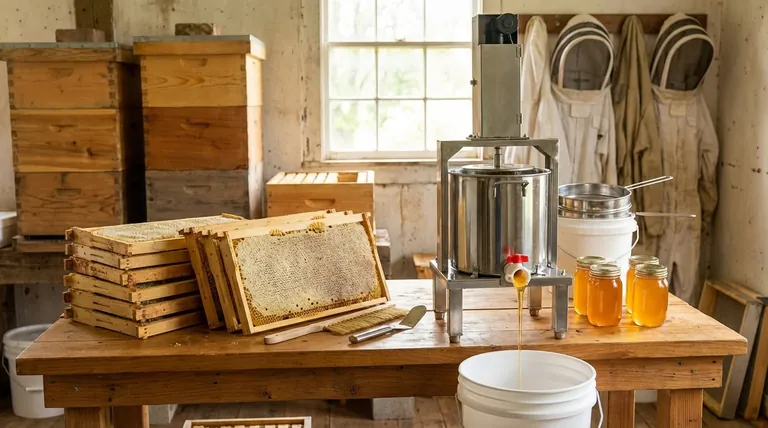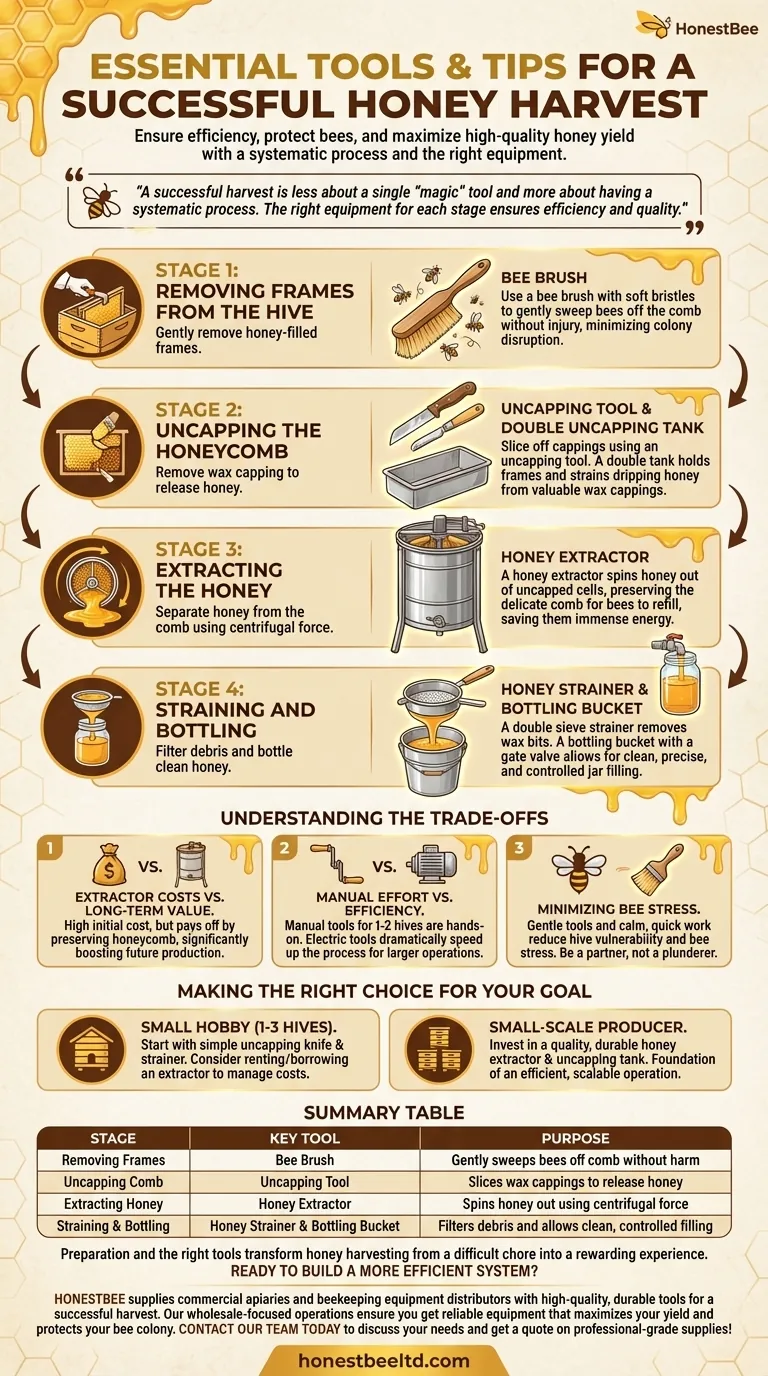To ensure a successful honey harvest, you need a specific set of tools designed for removing frames, uncapping honeycomb, extracting the honey, and then straining and bottling it. The core equipment includes a bee brush, an uncapping tool, a honey extractor, and a strainer system, all of which work together to maximize your yield while minimizing stress on the bee colony.
A successful harvest is less about a single "magic" tool and more about having a systematic process. The right equipment for each stage—from hive to jar—ensures efficiency, protects the bees' hard work, and results in clean, high-quality honey.

The Four Stages of Honey Harvesting
A smooth honey harvest follows a logical progression. Understanding the tools required for each stage is the key to an organized and low-stress operation for both you and your bees.
Stage 1: Removing Frames from the Hive
The first step is to gently and safely remove the honey-filled frames from the super (the box where honey is stored).
Your primary tool here is a bee brush. Its long, soft bristles are designed to gently sweep bees off the comb without injuring them. This is far less disruptive to the colony than shaking frames vigorously.
Stage 2: Uncapping the Honeycomb
Bees seal each cell of honey with a thin layer of beeswax, known as "capping." This wax must be removed to release the honey.
An uncapping tool is used to slice off these cappings. This can be a simple uncapping knife, a fork-like scratcher, or a spiked roller. The collected wax cappings are valuable and can be rendered for other uses.
For efficiency, many beekeepers use a double uncapping tank. This setup holds the frame for you while you work and has a strainer to separate the dripping honey from the wax cappings, saving every last drop.
Stage 3: Extracting the Honey
This is where the bulk of the honey is separated from the comb.
A honey extractor is the most critical piece of equipment for this stage. It's a large drum that uses centrifugal force to spin the honey out of the uncapped cells without destroying the delicate honeycomb.
Preserving the comb is a massive advantage. The bees can immediately begin refilling the drawn-out comb, saving them the immense time and energy it would take to build it from scratch.
Stage 4: Straining and Bottling
The raw honey coming out of the extractor will contain small bits of wax and other hive debris.
A honey strainer or filter is essential for producing clean, clear honey. Most setups involve a double sieve—a coarse filter on top of a fine one—that sits over a food-grade bucket.
Finally, a bottling bucket with a gate valve at the bottom allows you to fill your jars cleanly and with precise control, minimizing mess and waste.
Understanding the Trade-offs
Choosing your equipment involves balancing cost, scale, and your beekeeping philosophy. There is no single right answer, only the best choice for your situation.
Extractor Costs vs. Long-Term Value
A honey extractor is the single largest investment for a new beekeeper. While the initial cost can be high, it pays for itself by preserving your honeycomb, which significantly boosts the next season's honey production.
Manual Effort vs. Efficiency
Electric uncapping knives and motorized extractors can dramatically speed up the harvest process. However, for a beekeeper with only one or two hives, manual tools are often more than sufficient and offer a quieter, more hands-on experience.
Minimizing Bee Stress
Every choice you make has an impact on the colony. A gentle bee brush is better than a harsh blower. Working calmly and quickly reduces the time the hive is open and vulnerable. The goal is to be a partner to your bees, not a plunderer.
Making the Right Choice for Your Goal
Your harvesting strategy should align with the size of your apiary and your personal goals as a beekeeper.
- If your primary focus is a small hobby with 1-3 hives: Start with a simple uncapping knife and strainer, and consider renting or borrowing an extractor from a local beekeeping club to manage costs.
- If your primary focus is growing into a small-scale producer: Invest in a quality, durable honey extractor and an uncapping tank. These tools are the foundation of an efficient and scalable operation.
Ultimately, preparation and the right tools transform honey harvesting from a difficult chore into one of the most rewarding experiences in beekeeping.
Summary Table:
| Stage | Key Tool | Purpose |
|---|---|---|
| Removing Frames | Bee Brush | Gently sweeps bees off comb without harm |
| Uncapping Comb | Uncapping Tool | Slices wax cappings to release honey |
| Extracting Honey | Honey Extractor | Spins honey out using centrifugal force |
| Straining & Bottling | Honey Strainer & Bottling Bucket | Filters debris and allows clean, controlled filling |
Ready to build a more efficient and productive honey harvesting system?
HONESTBEE supplies commercial apiaries and beekeeping equipment distributors with the high-quality, durable tools needed for a successful harvest—from bee brushes and uncapping tanks to honey extractors and strainers. Our wholesale-focused operations ensure you get reliable equipment that maximizes your yield and protects your bee colony.
Contact our team today to discuss your specific needs and get a quote on professional-grade harvesting supplies!
Visual Guide

Related Products
- 10L Stainless Steel Electric Honey Press Machine
- Electric Flatting and Embossing Machine with Tray for Beekeeping
- Stainless Steel Manual Honey Press with Guard for Pressing Honey and Wax
- Stainless Steel Honey Press Wax Press with Tank
- Professional Wide Blade Honey Scraper for Beekeeping and Honey Processing
People Also Ask
- What are the benefits of the screw design in a stainless steel honey pump? Preserve Honey Quality and Integrity
- How does the press method for extracting honey work? A Simple, Low-Cost Guide for Beekeepers
- How does pressed honey compare to extracted or crush-and-strain? Unlock the Full Flavor of the Hive
- What happens to the wax after pressing in a honey press? A Guide to Maximizing Your Hive's Yield
- What are the unique characteristics of honey presses? Maximize Honey Yield for Small-Scale Beekeeping



















